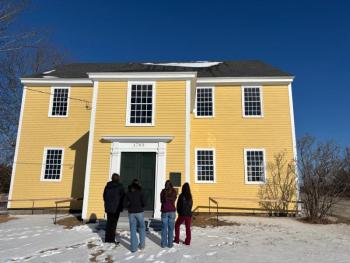Image Id 679517 for Node 255075
Wiscasset Advanced Placement (AP) History students studied historic Head Tide in Alna Jan. 28.
The Head Tide mills were in a busy village that also had apple orchards, boat building, and fishing. The Head Tide Historic District was added to the National Register of Historic Places in 1974.
Elijah Bouchard said, “Alna was a lucrative town in the 18th to the 20th century, and the inhabitants of this important town were able to utilize the river marvelously by transforming it into the Head Time dam. By doing this, the people of Alna were able to produce a surplus of lumber and fish, while providing a plentiful supply of wealth.”
One of the first industries in Maine, beginning in the early 1600s, was the sawing of white pine lumber. Since that time, nearly every tree species found in the state has been used for a wide variety of wood and paper products, and the forest products industry has been a very important part of Maine's economy.
Xoe Morse said, “It's interesting to learn how and where we lived used to be so influential. It provided mill power for so many and was very important for transport, transporting over two and a half million feet of logs through the town.”
Alna's early mills were along the Sheepscot River in the Head Tide, Puddle Dock and Sheepscot Village areas. The mills were used to saw lumber, grind grain, and produce other goods which led to economic development of Lincoln and Kennebec counties.
Ijesity Rhinebolt said, “As I continue Mr. Cotta's class, I learn more and more about the abundant and unknown history about the area I live in. The abundance of wealth as well as the economic position of Maine, especially the Alna region, was at an all-time high during the 19th century. Two and a half million feet of lumber went down Head Tide at one point, which is just insanity to think about.”




























